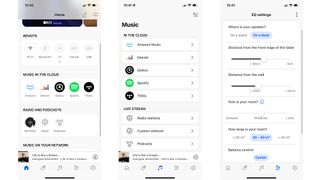KEF LSX II LT
KEF LSX II LT review
Lower price, fewer features, but still absolutely excellent Tested at £899 / $999 / AU$1695
By What Hi-Fi?

(Image: © What Hi-Fi?)
What Hi-Fi? Verdict
All the class and poise of the Award-winning KEF LSX II in a streamlined, more affordable package? Count us in
Pros
- Cohesive, effortlessly balanced performance
- Full, well-formed bass
- Great value for most users
- Compact, desktop size
Cons
- No aux input
- Less luxurious finish options
- Loss of wireless link between speakers
As a versatile, superb sounding and delightfully well-made wireless speaker system that seemingly does it all without costing you the earth, the KEF LSX II is without equal. As its 2023 What Hi-Fi? Award attests, there is simply nothing at the price (around £1199 / $1400 / AU$2195) that will give you such a confident, composed sound while also delivering a raft of streaming features without the need for the complexities of separate amplifiers, DACs or source components.
Or so we’ve always thought. We considered the LSX II’s tantalising recipe of offering extensive streaming features inside some of the best compact speakers around was tough to beat, but the whole concept of the new and more relatively affordable KEF LSX II LT makes a whole lot of sense.
By dropping the option of a wireless link between the speakers, the aux input and a few colourway options, KEF has been able to bring the price of this new LS model down to £899 / $999 / AU$1695 without sacrificing the core appeal of the product itself.
Build & design

(Image credit: What Hi-Fi?)
The LSX II LT speakers are pretty much indistinguishable from the standard LSX II in terms of their general compact size and shape, while KEF’s iconic tangerine waveguide and shiny Uni-Q driver array once again draw the eye without the speaker’s fascia ever seeming overcluttered or overtly showy.
What you don’t get is an attractive cloth-covered option with this “lite” LT version, with KEF offering just three, clothless shades for this cheaper iteration in comparison with the LSX II model’s five. But our sage green review pair (stone white and graphite grey are also available) still look handsome enough when placed upon our listening room’s speaker stands or on a desk.
They feel nice, too, and while we’re in the process of moving the units around and testing how they sound in different positions on speaker stands and on a desk, they always feel solid and dependably well-made. The ridged back panel is a nice touch, even if you don’t see it much, while the smooth, unshowy cabinets never seem as though they’ll be susceptible to scuffs or markings. The odd fingerprint might show up occasionally, but that’s the worst we experienced. All in all, the LSX II LT is a handsome, well-made speaker system that looks at home pretty much anywhere.
These speakers still use the 11th-generation 11.5cm Uni-Q driver array, where the tweeter sits in the middle of the mid/bass unit. This kind of design has all sorts of advantages over conventional separate driver arrangements including more even sound dispersion, better integration and improved time alignment. It is a bit of a shame that the company’s excellent ‘MAT’ metamaterial absorption driver technology (which absorbs the rearward sound from the back of the tweeter dome) hasn’t featured here, but that’s down to cost reasons.
The LSX II LT are true active speakers with a Class D power amplifier dedicated to each drive unit. The amplification power output totals 200 watts, with 30 watts driving the tweeter and 70 watts powering the mid/bass for each channel.
KEF LSX II LT TECH SPECS

Driver Uni-Q driver array (19mm aluminium tweeter; 11.5cm aluminium mid/bass)
Max power 100W per channel
Streaming AirPlay 2, Google Chromecast, UPnP, Bluetooth 5.0
Streaming services Spotify Connect, Tidal Connect, Amazon Music, Qobuz, Deezer
Max resolution support 24-bit/384kHz PCM, DSD128
Inputs HDMI ARC, USB-C, optical, Ethernet
Output Subwoofer
Dimensions (hwd) 24 x 15.5 x 18cm
Weight 6.8kg (total)
Finishes x3 (graphite grey, stone white, sage green)
Features

(Image credit: What Hi-Fi?)
So what does the KEF LSX II LT sacrifice in terms of connectivity? For one thing, there’s no analogue aux input to be found, meaning a physical connection to certain source players such as laptops or portable music players might be made a little trickier. However, the speakers’ USB-C port should provide a workaround for most modern source devices.
That leaves the LSX II LT a little more sparse when you flip them around to look behind, but the key connectivity options, including an HDMI ARC port for your TV, an optical input and even a subwoofer output, remain present. Unlike the standard LSX II for which both speakers need to be plugged into the mains, the LT only require a single mains lead plugged into the primary unit, with the other speaker then taking the power via a 3m USB-C interspeaker cable. Thankfully, the LT sports an upgraded power supply to cope with the extra demand.
The above also means that a wireless connection isn’t available between the speakers, which now must be tethered physically together at all times. It’s a departure from the standard LSX II which could utilise either a wired or wireless link between both speaker units.
In terms of supported streaming smarts, the spec sheets are pretty much identical. The LSX II LT still utilises KEF’s own streaming platform, providing a gateway to the myriad connectivity options on offer including Apple AirPlay 2, Google Chromecast and Bluetooth 5.0. Amazon Music, Deezer, Qobuz, Spotify Connect, Tidal Connect and internet radio are all onboard and accessible via the KEF Connect app, and you can once again stream high-res music from a connected external NAS drive. Do note, however, that these LT speakers aren’t Roon Ready, unlike their more expensive siblings.

(Image credit: What Hi-Fi?)
Fundamentally, it’s an easy app to use, and while we might have initially struggled to find a few given functions, those teething problems soon melt away as we get to grips with the overall layout. Access to your streaming services, playback and source selection, not to mention volume control and EQ, are all there for you in one place, and although it isn’t the most beautiful app to behold, it’s in-depth and navigable enough to be a help rather than a frustrating hindrance.
While we’re on the subject, we like that KEF offers EQ settings (adjustable via said app) to tailor the sound according to where you’ve placed the speakers, and we find it really does make a difference to the sound you’ll receive. The settings available will allow you to take into account factors such as room size and the speakers’ distance from the wall (or desk edge), and a quick play around with the provided sliders will tangibly affect the sonic performance and profile of the entire system. To get the best out of the LSX II LT, make sure you spend some time checking your settings first.
Sound

(Image credit: What Hi-Fi?)
Much of our in-house chat surrounding the arrival of the LSX II LT revolved around how the new speaker system would sound when compared with its Award-winning counterpart, and even though KEF has promised the same sound at a more affordable price, fears of a drop in audio quality inevitably crept in, with concerns that a shared inter-speaker power supply might result in some sonic sacrifice.
Thankfully, such fears were unfounded. To our ears, the spin-off shares the same sonic credentials as the LSX Il, with almost no sonic shortcomings when the two are directly compared side-by-side. If you loved the performance of the LSX II system, you’ll likely be enamoured by what this new LT version is offering, too.
Perhaps that shouldn’t surprise us, with both speaker pairs sharing the same driver units, cabinet sizes and internal electronics. Loading up a Tidal rendition of Muse’s Madness quickly quells such worries that the LT are in any way “lite” on the audio front - whether played through the Award-winning LSX II or the LT, there’s a solidity, crispness and breadth of bass that all belie a streaming system of this size. We’re hooked, and we’re keen to see if further offerings reap similar rewards for the newer iteration.
Happily, they do, with the LT offering punch, focus and a snappy sense of propulsion without a hint of fuss or strain. There’s very little fatness to the KEFs, and while that might have you summoning adjectives such as “thin” or “lean” in your mind, the LSX II LT instead feel immediate, taut and controlled, like a ballerina’s calves as they perform a perfect plié. The ballet dancer analogy is an apt one, in fact, with the LT also conjuring the sort of subtle mix of emotional expression and insight combined with the deft aptitude for control, poise and perfect balance so often exhibited by the likes of Fonteyn or Nijinsky.
Balanced, the system certainly is. The top end very rarely strays into over-enthusiasm, and that meaty bass, while forceful and surprisingly weighty considering the size of the units, never allows itself to become indulgent or flabby. Run The Jewels’ The Ground Below has plenty of beef in the lower ranges, and while lesser systems might let it become overbearing or overly swollen, the LSX II direct that energy into something taut, precise and controlled.
All this talk of tightness and control shouldn’t make you think that the LSX II LT isn’t a system with an intuitive understanding of the music it so robustly pumps out, and as was the case with the standard LSX II, nuanced instrumental textures are afforded plenty of layers of detail. Hans Zimmer’s Discombobulate, for instance, is all about playing with textures, and the KEFs bend and flex to reflect the full range of strange, quirky timbres on display, be they the mischievous twangs of a cimbalom or the hurried, chaotic scratches of bows passing across the strings of a Victorian-style violin.
This sonic character remains consistent regardless of the medium or source used. We hook up the KEFs via USB-C to a MacBook Pro and find that same crisp tightness utterly unaltered, with a 24-bit FLAC file of Nick Cave’s Galleon Ship benefiting from plenty of the speakers’ refinement and organisational abilities. Playing a CD version of The Diary Of Alicia Keys also proffers similarly pleasing results, when connecting the Award-winning Arcam CD5 to the LT’s optical input.
Verdict

(Image credit: What Hi-Fi?)
If you’re not particularly bothered by losing a few extra connectivity options and features but still want that same tight, impressive sonic presentation, the KEF LSX II LT are a fantastic value alternative to the more illustrious, expensive LSX II model. By taking a great system and streamlining it without compromising the sound, the LSX II LT have nailed it.
SCORES
- Sound 5
- Features 5
- Build 5

